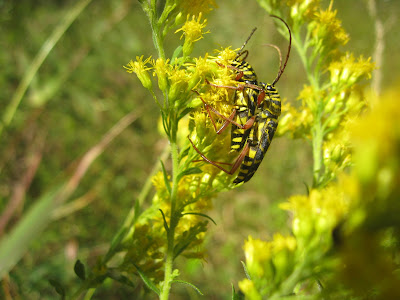 |
| A Green-Headed Coneflower provides nectar for multiple Sweat Bees, a Bumblebee, and Orange Mint Moth. |
There are over 200,000 species of pollinators worldwide. These include such diverse animals as bees, wasps, butterflies, moths, flies, beetles, and hummingbirds. We owe them much, as it is often said that one out of every three bites of food we enjoy is due to the direct actions of an animal pollinator. In fact, three-quarters of all plants, regardless of whether we eat them or not, depend on animal pollinators in order to reproduce. There are many basic things we can do to make our gardens and landscape more pollinator friendly:
• Avoid
using pesticides and/or herbicides.
• Plant
for continuous blooms throughout the seasons (so you have continuous food).
• Use
mass plantings (they’re easier to see by pollinators flying by)
• Include
host plants for caterpillar and oligolectic plants for bees (the native plants 1/5
of our native bees evolved with and need in order to reproduce).
• Provide
basking sites (they all need to warm up).
• Consider wet mud spots to serve as puddling areas for butterflies, mud plots for
mason bees/wasps.
• Try
to locate your garden in the sunniest location you have for the most blooms.
• Consider
flower color & shape (white, yellow or blue composite flowers are often
best).
• Avoid
double-flowered or other cultivars (cultivars are chosen for traits people
want;
evolution
chose what the pollinators want).
• Leave
old stalks, if not diseased, to overwinter. If you can cut stalks to a foot or so
high and leave them for the new growth to grow over, you can provide nesting spots
for insects such as bees, of which 30% nest in places like old stalks. It will still look
neat, but provide nesting platforms throughout the year. If you resist the urge to
clean up and remove fallen leaves, you also provide good habitat.
• Go
Native!
- They provide more food/shelter for the animals with whom they evolved. 96%
of terrestrial birds feed their young caterpillars (and sawflies) as their major food source,
particularly while nesting. All 17 of our bat species feed on insects preferring moths
(which of course are adult caterpillars).
- They are preferred by native wildlife (with whom they evolved). Indeed many are
necessary as host plants for caterpillars and 1/5 of our bees.
- Given that most insects lay large number of eggs, supplying the plants they need can
make a big difference locally. Of all the insects that feed on plants, 90% are specialists
needing the native plants they evolved with, and many of these are pollinators such as
butterflies and bees.
- They are adapted to our environmental and soil conditions in which they evolved.
- There are so many to choose from adapted to just about every growing condition (over
1700 species in NoVA alone).
- The same plants can have multiple uses (aesthetics, edible landscaping, herbal, wildlife
gardening, etc.).
- They are attractive!
So do your part for pollinators and other wildlife by following these guidelines, most especially by going Native!
 |
| A Bumblebee and Monarch Caterpillar share a Swamp Milkweed. |







